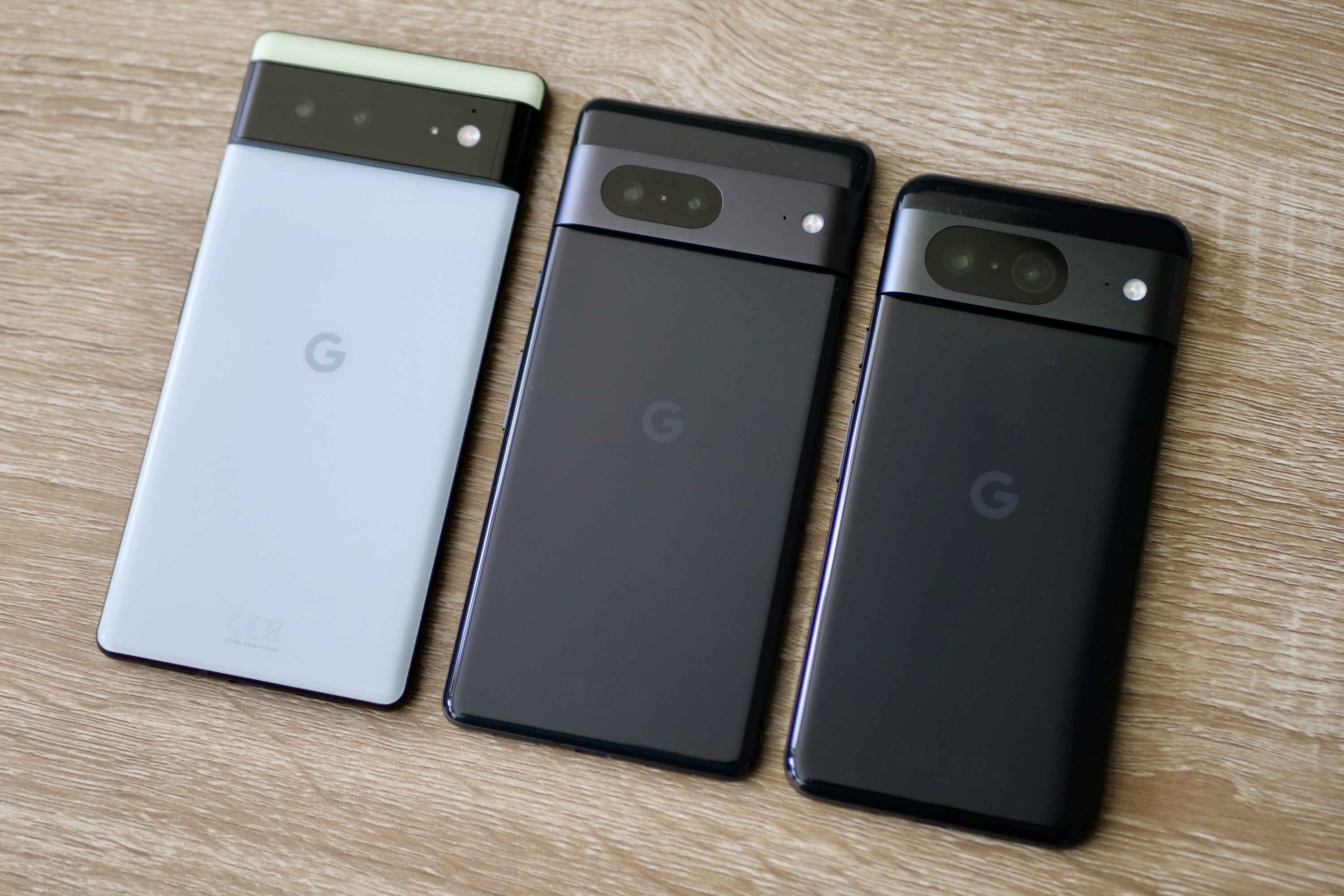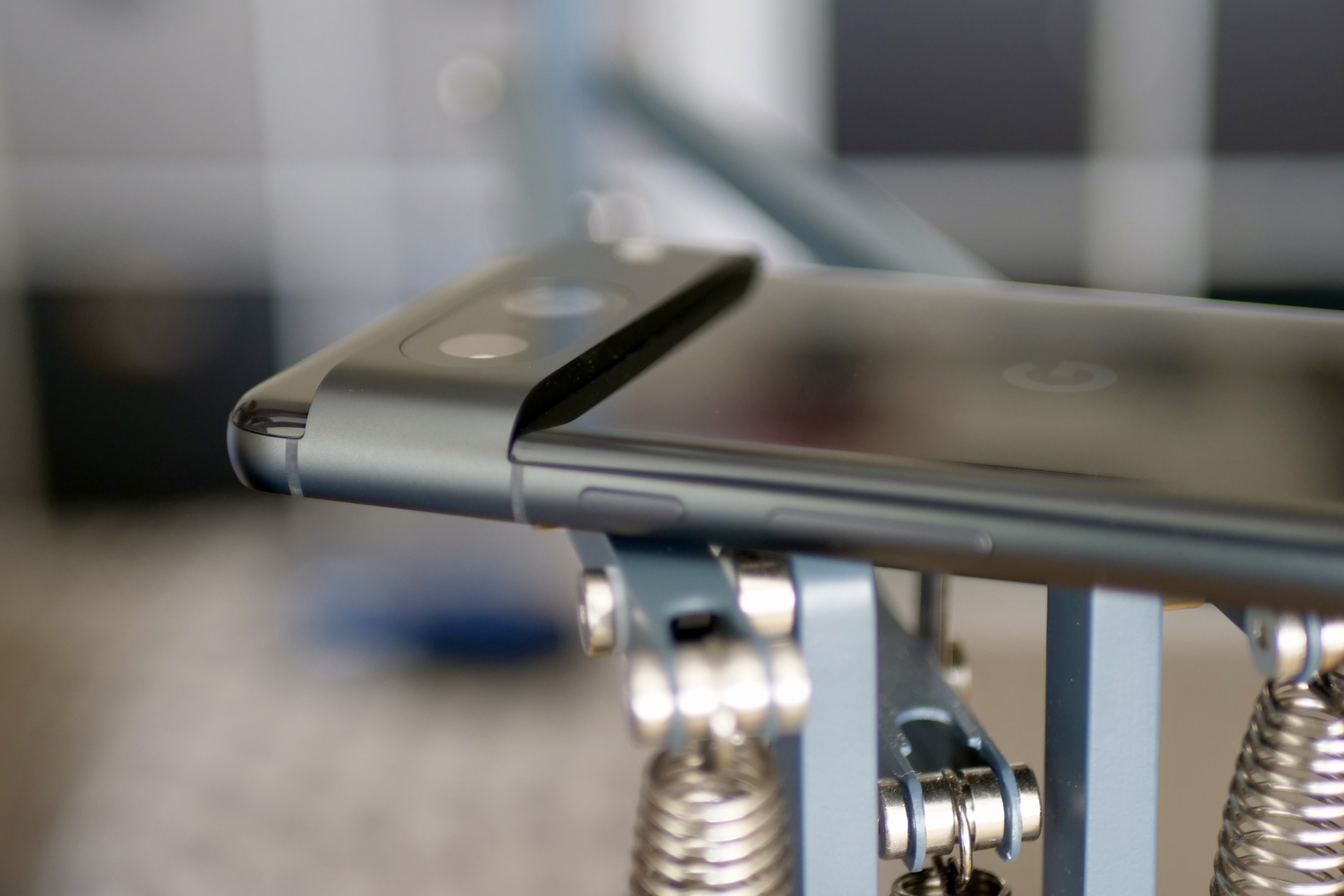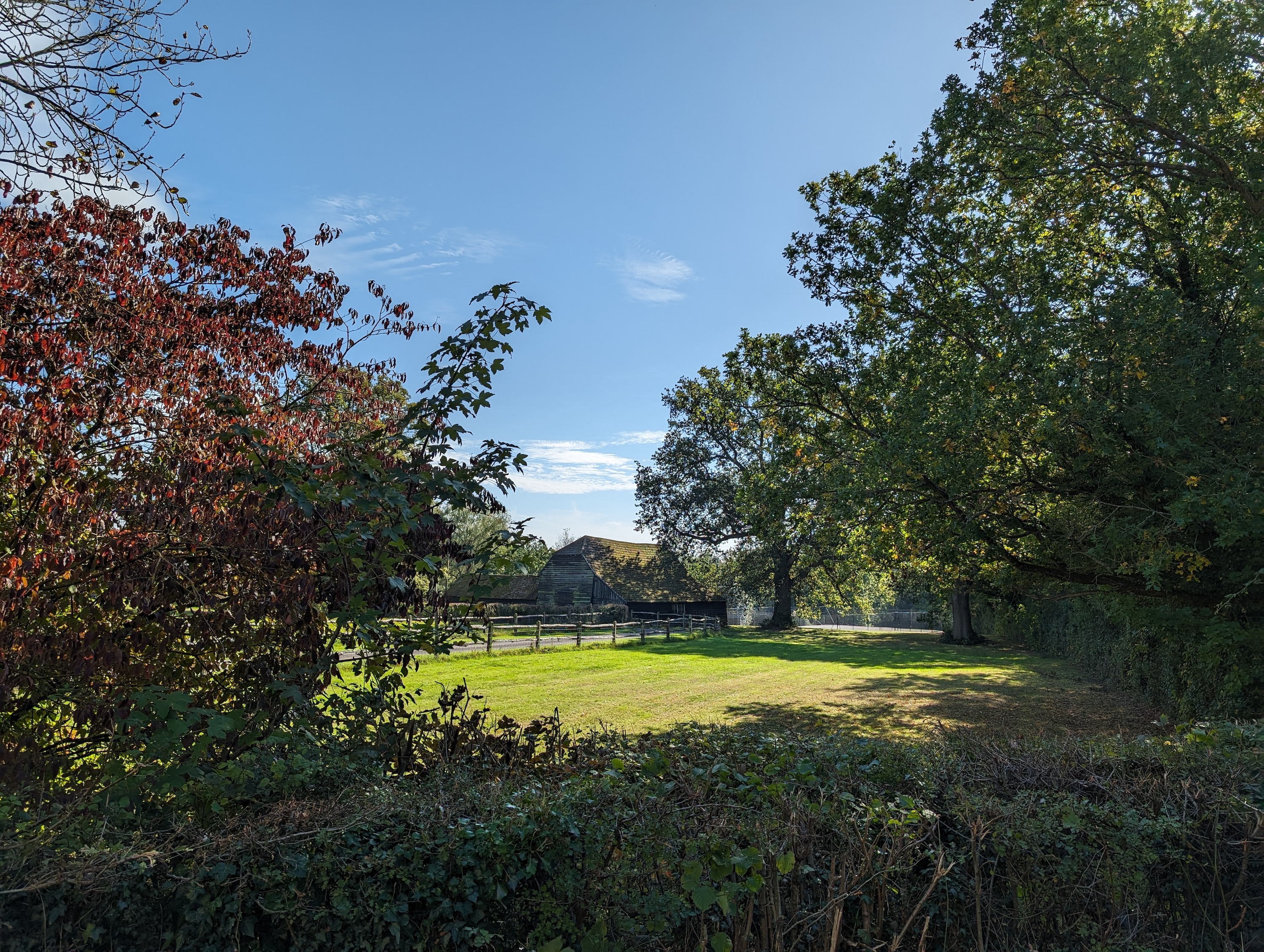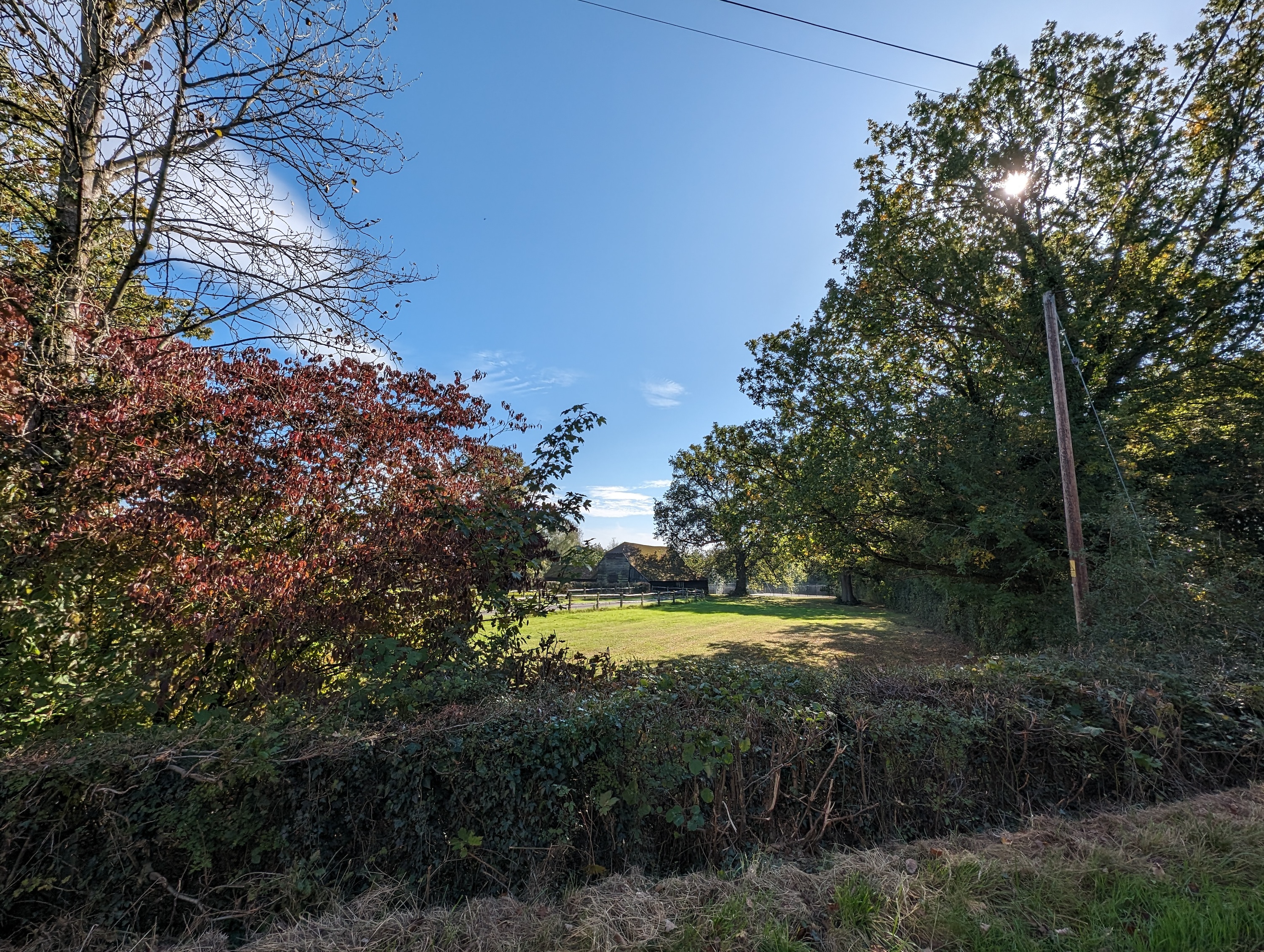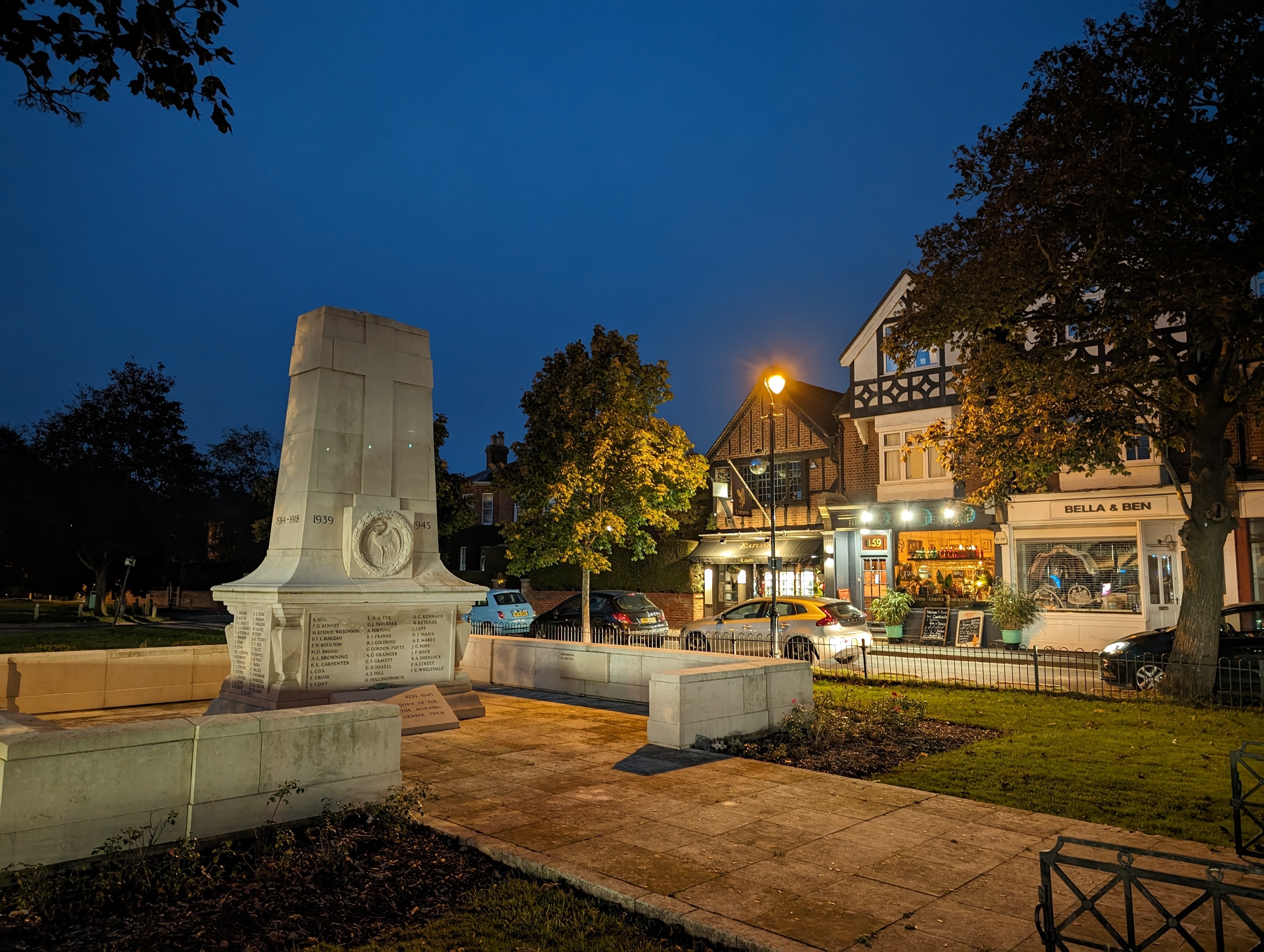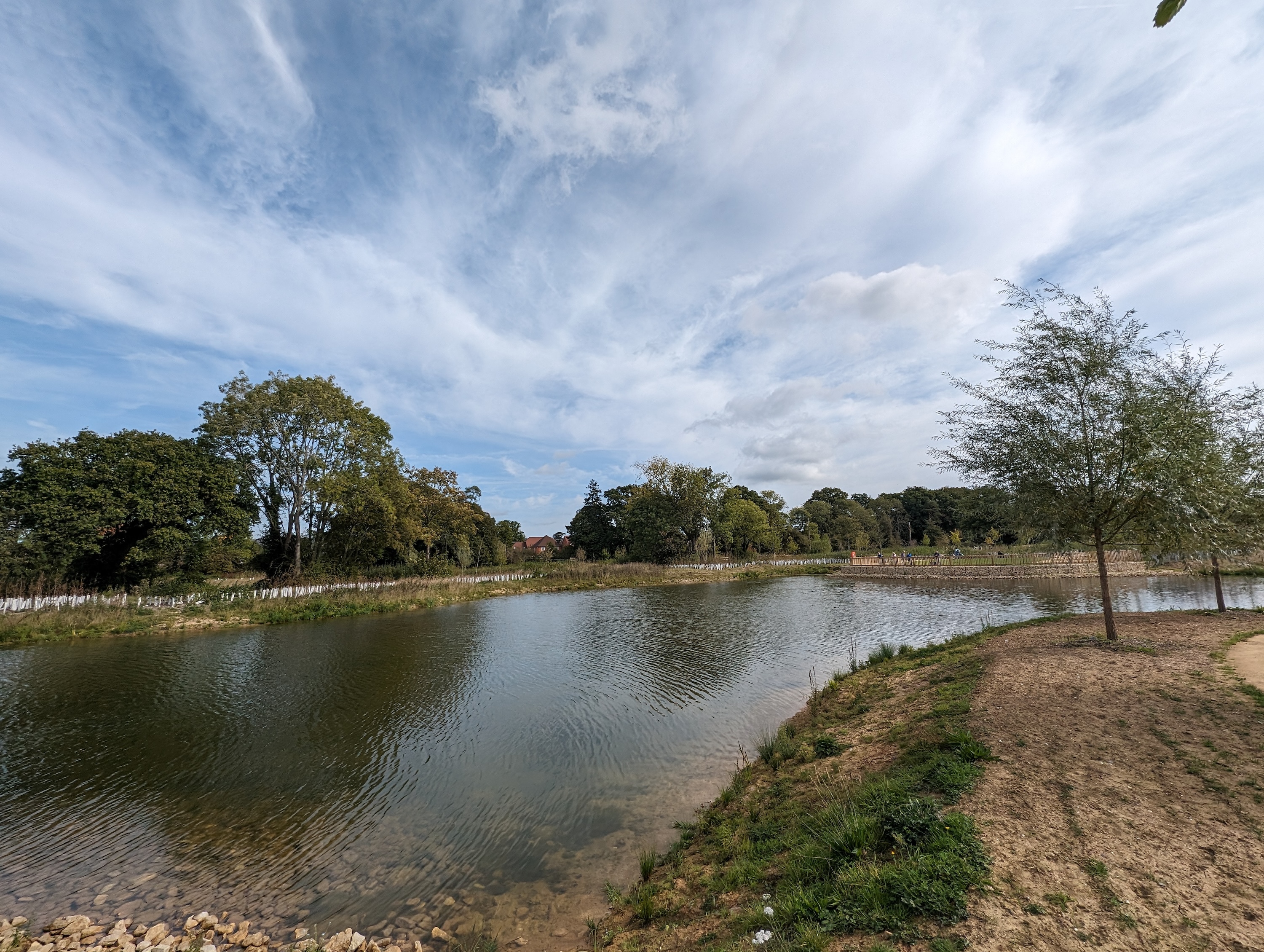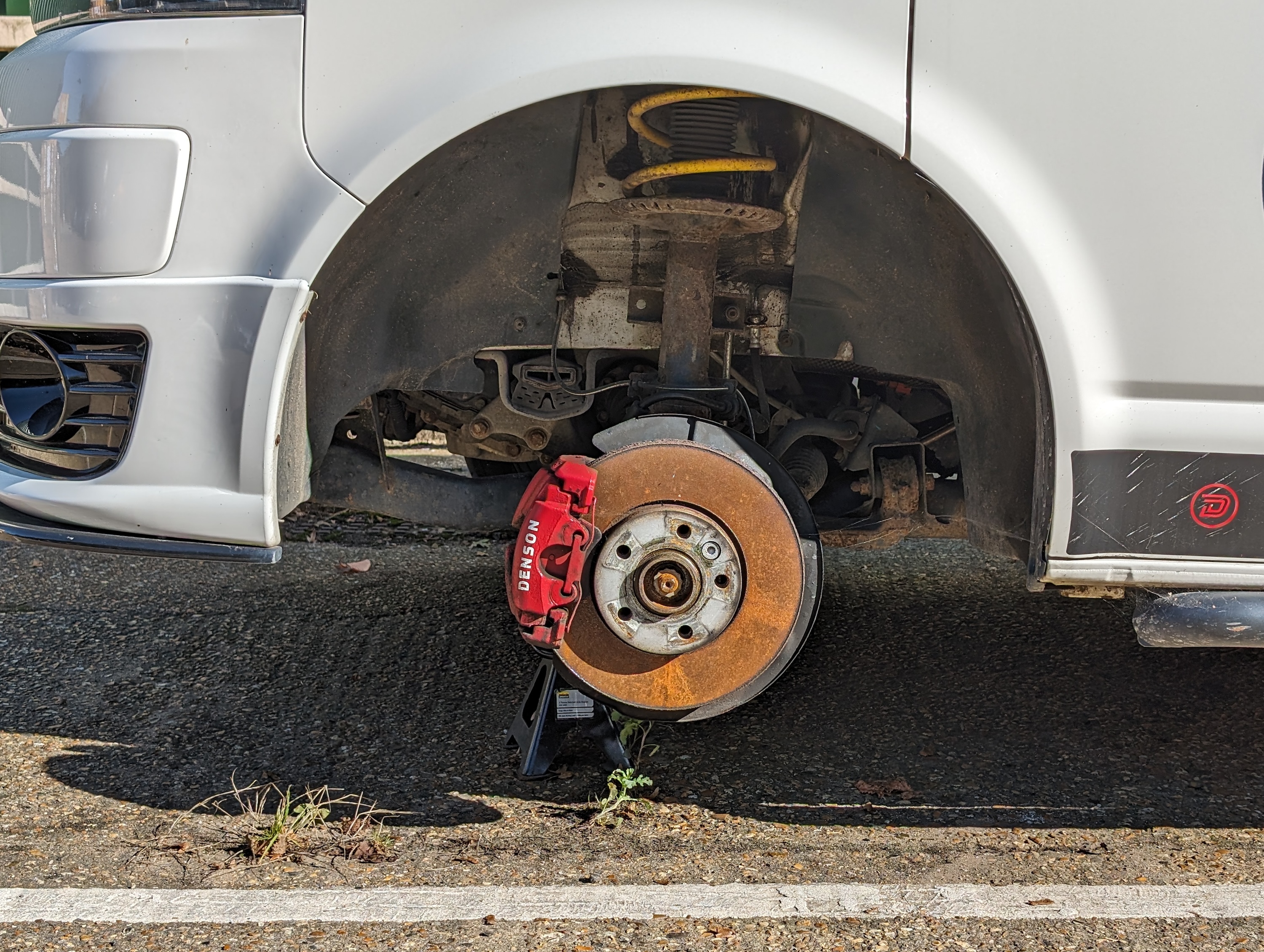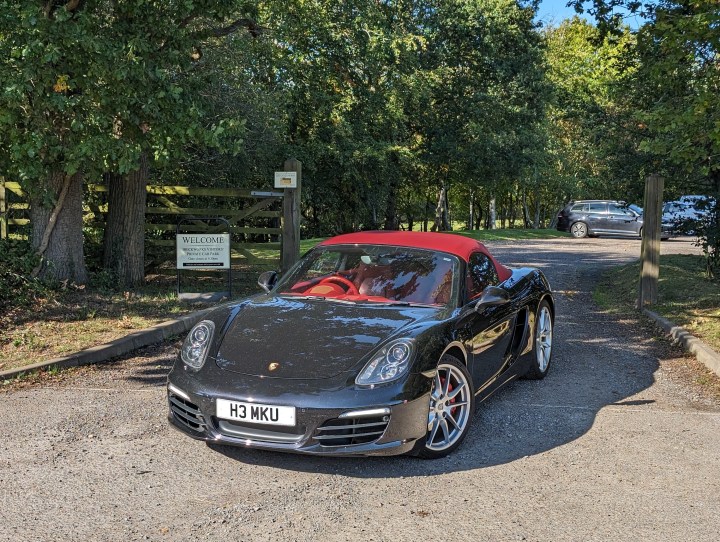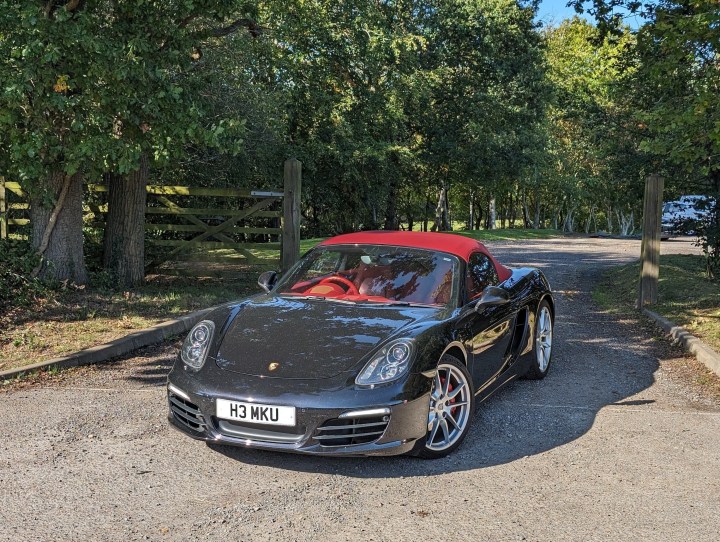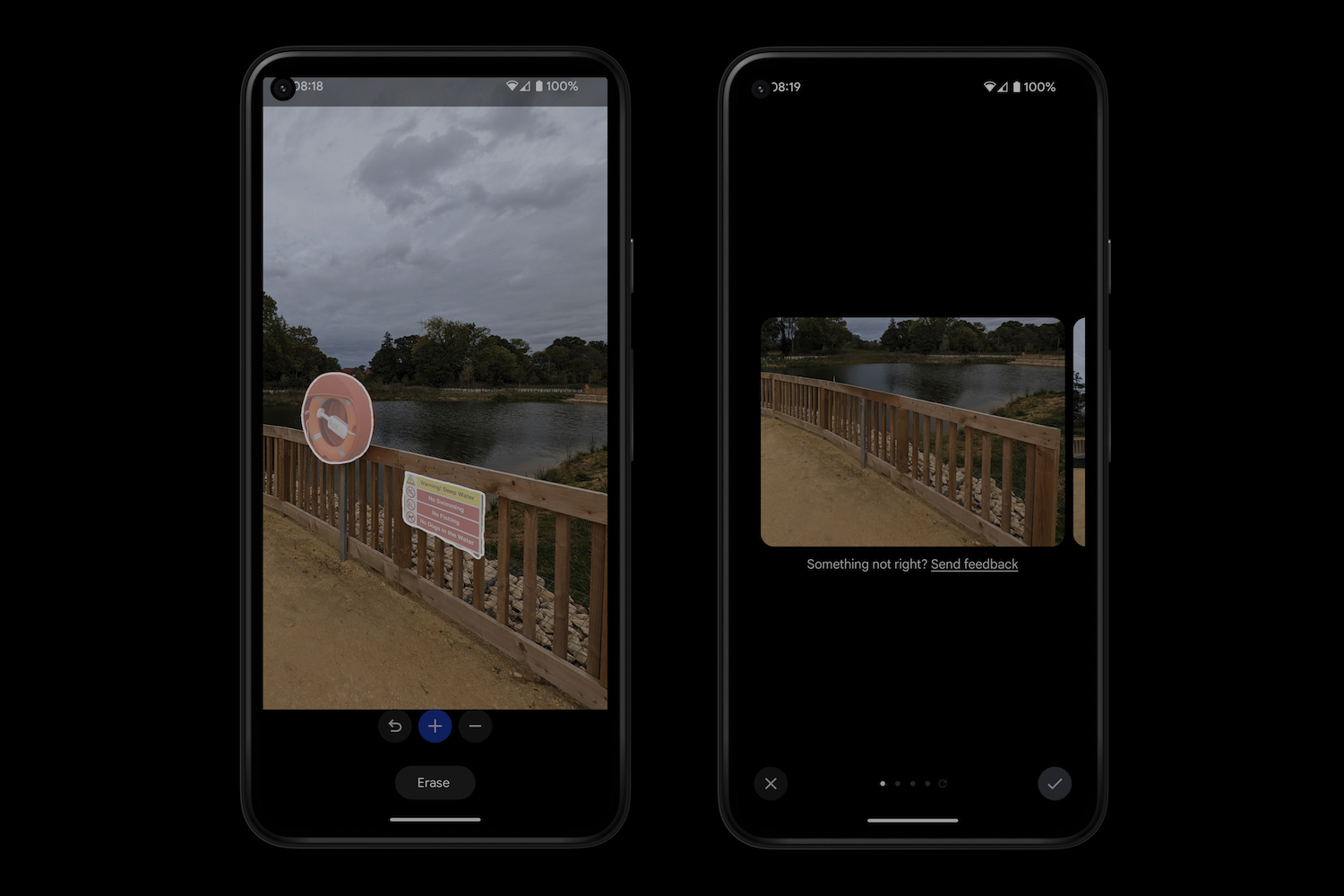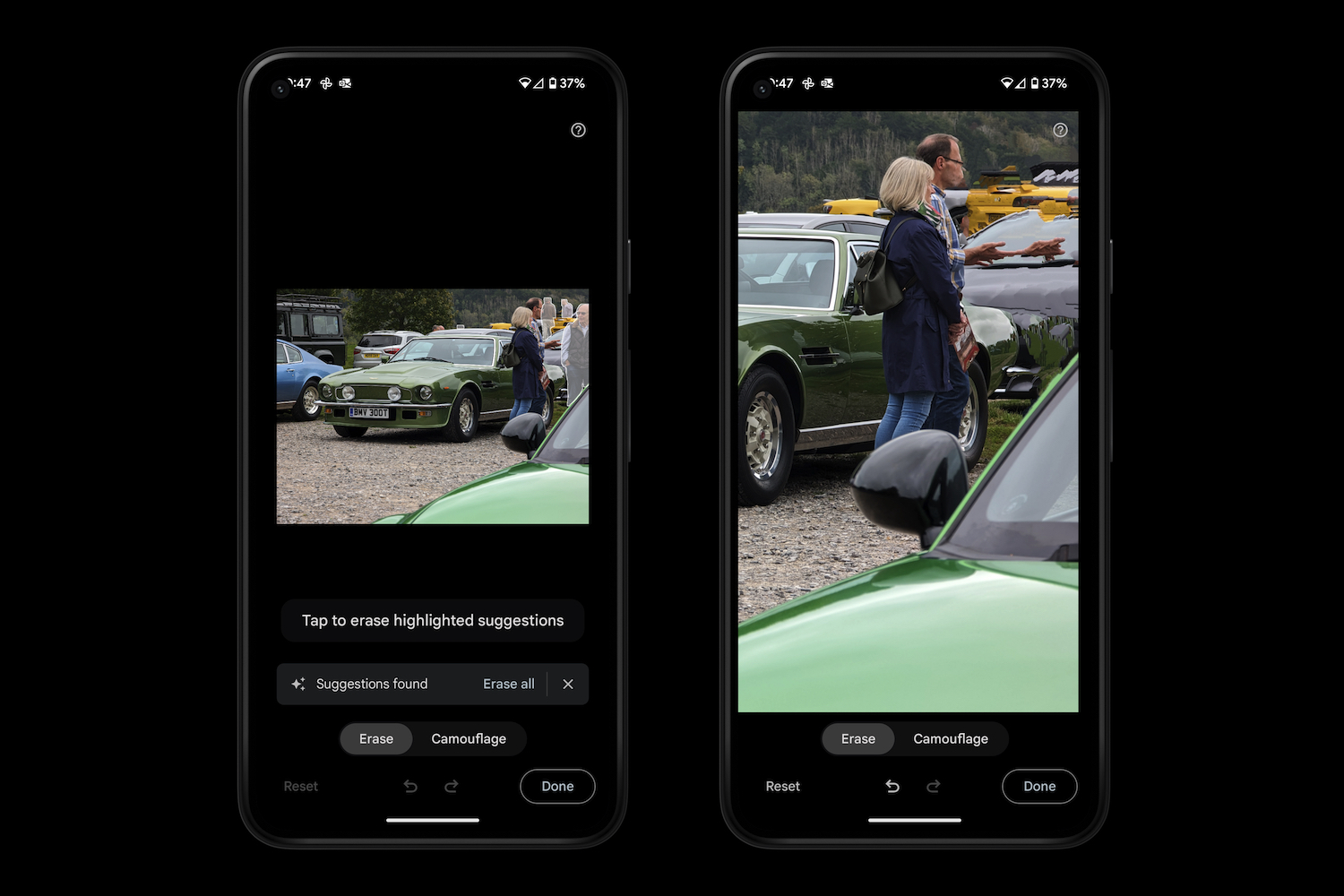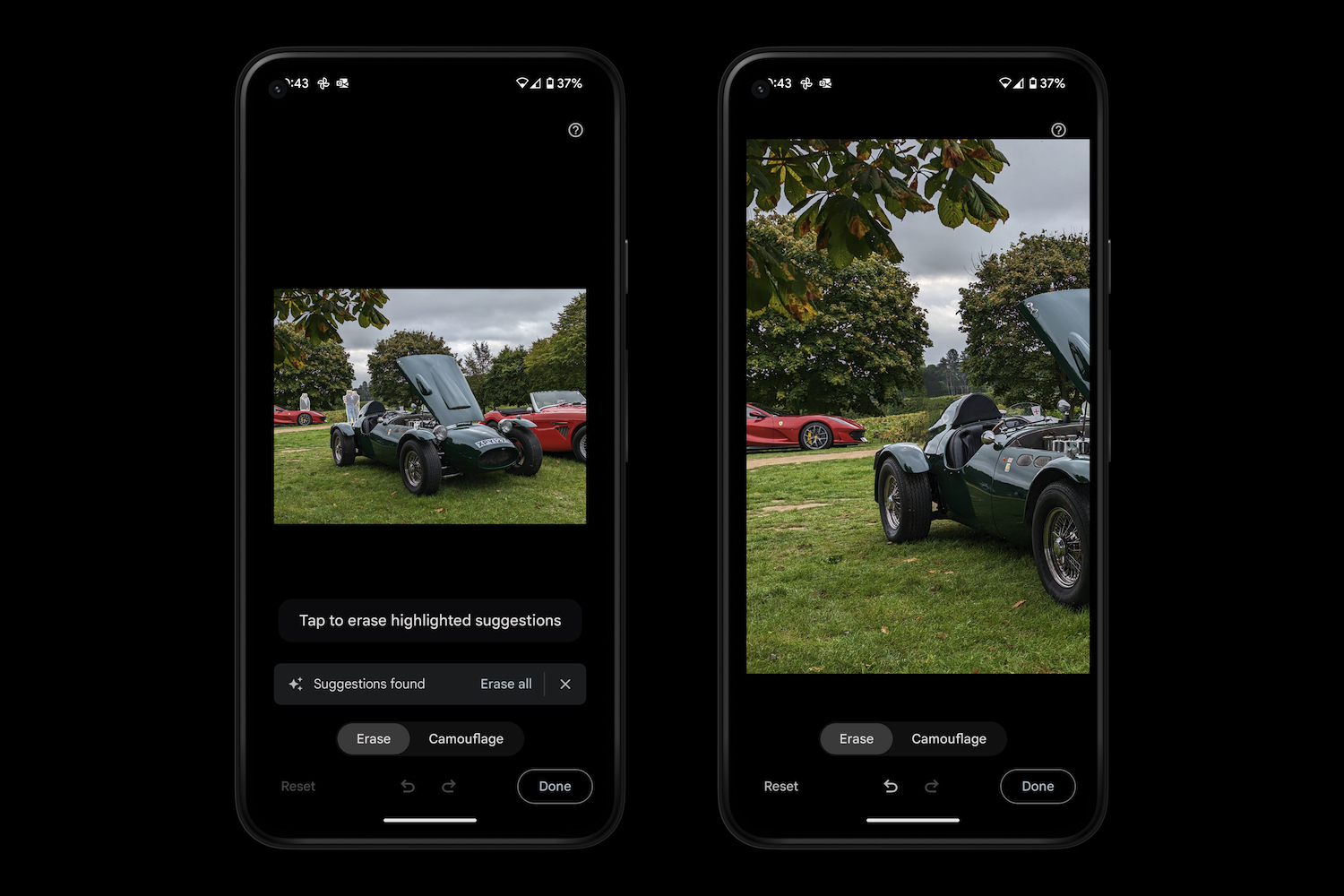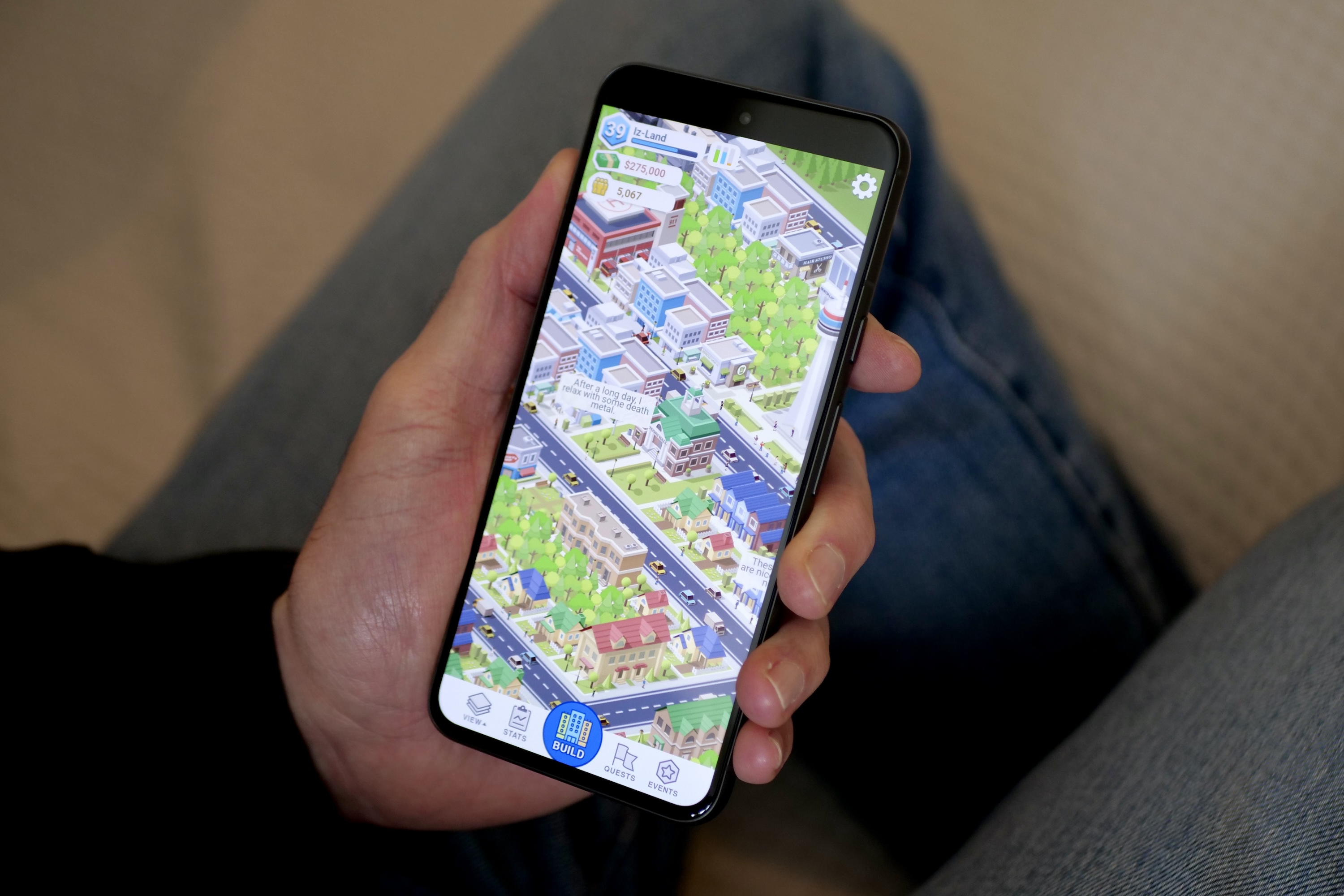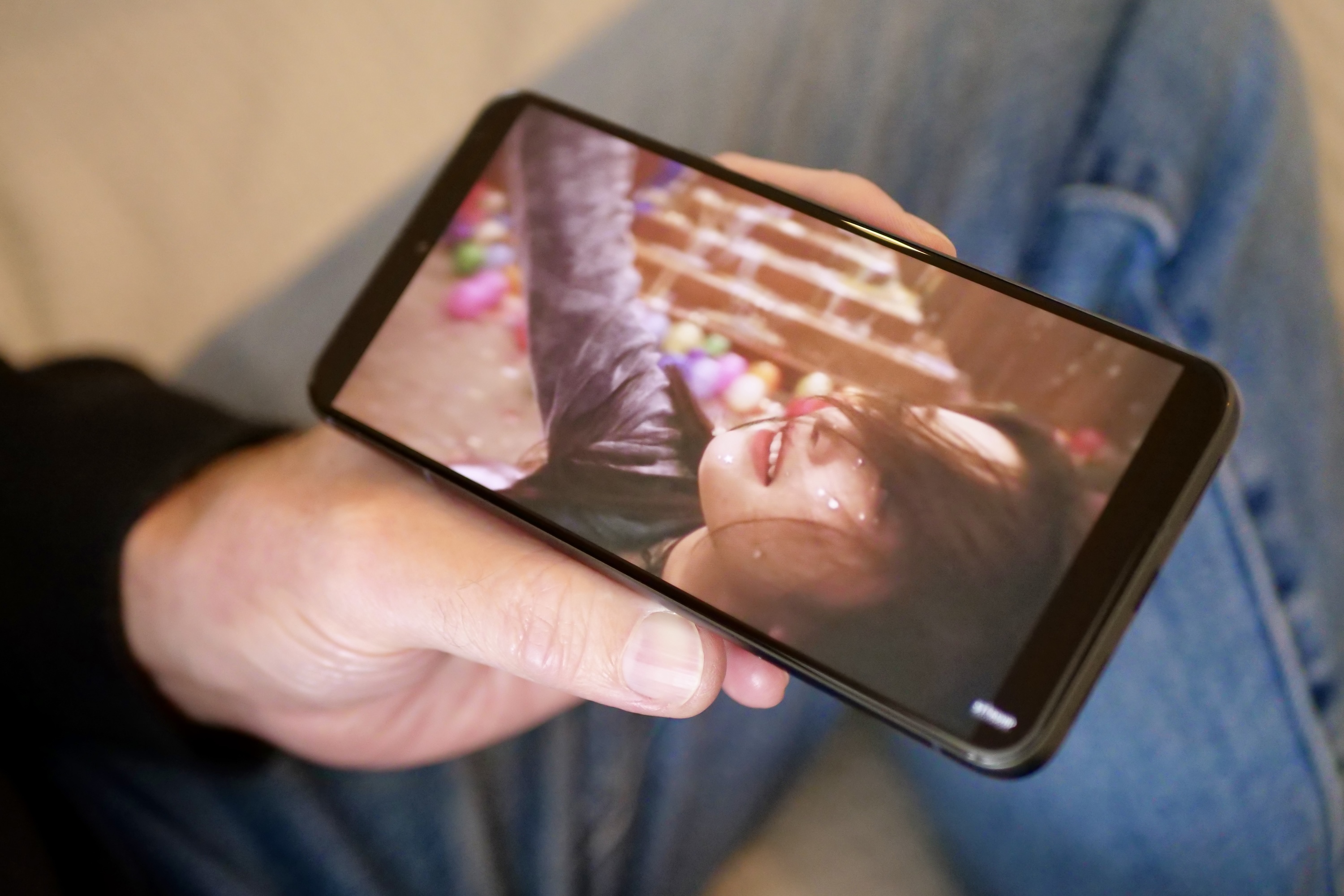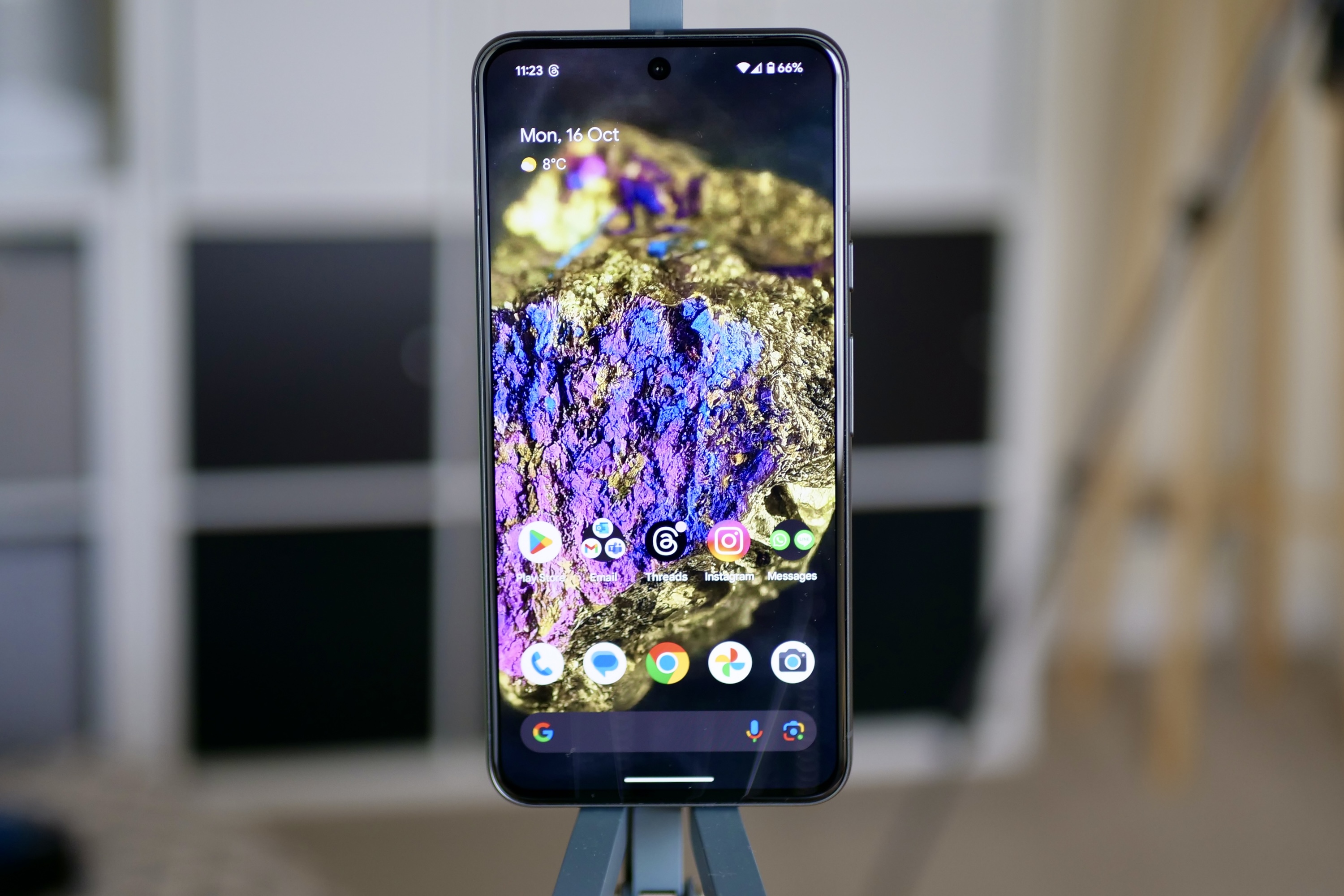“The Google Pixel 8 packs amazing AI tools, great cameras, and long battery life into a pretty, compact body.”
- Great main camera
- Amazing AI photo editing tools
- Two-day battery life
- Slick, fast Android 14
- Tensor G3 is cool and efficient
- Seven years software support
- Wide-angle camera disappoints
- Average charge speed
The Google Pixel 8 sits in the shadow of the Google Pixel 8 Pro. It’s not its fault, but it’s always that way when one phone is labeled Pro and the other is not. It’s seen as the “cheap” option and, therefore, the less desirable model.
I’ve been using the Google Pixel 8 as my main phone for a while now, and there is no way you’re being short-changed if you chose it. Let’s go into detail about why you shouldn’t immediately just go Pro with your new Pixel.
About our Google Pixel 8 review
Our Google Pixel 8 review was written and published by Andy Boxall after using the phone for over a week in the United Kingdom. It was updated in April 2024 by Joe Maring, who wrote the “six months later” section below after revisiting the Pixel 8 for a couple of weeks in the U.S.
Google Pixel 8: six months later
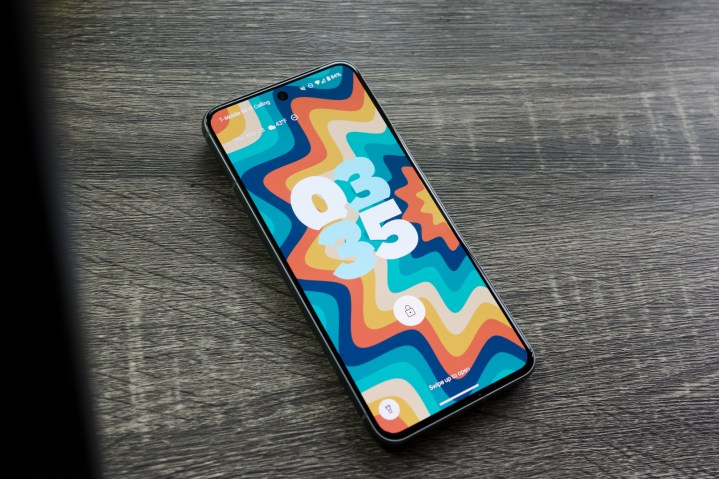
It’s been about six months since the Google Pixel 8 hit the scene. We’ve been treated to a lot of great Android phones since then, be it the Samsung Galaxy S24 or the OnePlus 12. Although those phones are stiff competition for Google, the Pixel 8 still manages to stand out as something special.
Six months post-release, almost everything that was great about the Pixel 8 at launch remains just as good in April 2024. The compact size is wonderful, the display is lovely, and the camera is just as reliable as ever. Google’s Android 14 software continues to impress, too. I still love the simplicity of it, and the extra features Google has added on are legitimately useful. Circle to Search is one of the most recent additions, and although I don’t use it constantly, I’m always happy it’s there when I do need it.
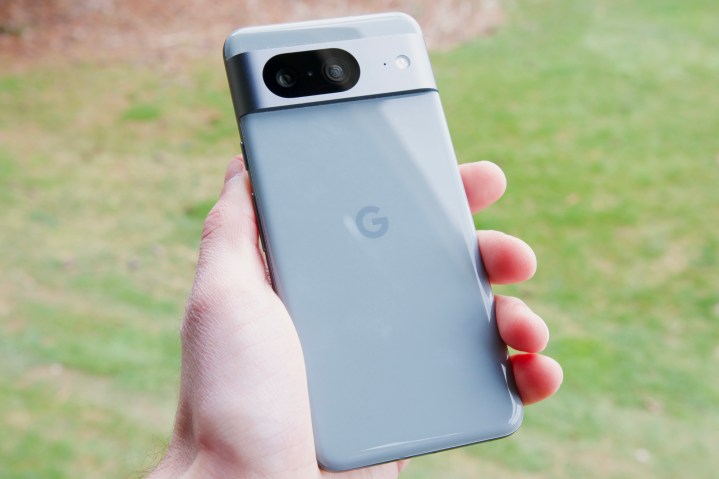
Like any phone, though, the Pixel 8 hasn’t aged perfectly. I’ve found the battery life to only be good for about a full day of use, which is less than what Andy found during his testing. The Tensor G3 chip has also frequently reminded me that I’m not using a phone with a Qualcomm Snapdragon processor — be it the Pixel 8 getting warm after a few minutes of gaming, or apps randomly locking up for no apparent reason. They aren’t game-breaking issues the way the Tensor G2 was for the Pixel 7 series, but they’re still things I notice.
The Google Pixel 8 has fiercer competition than ever before right now, and in some regards, it’s not quite as easy of a recommendation as it was a few months ago. But subjectively, it’s a phone I can’t help but love. It’s cute, comfortable, easygoing, and a phone I don’t have to think too much about. More often than not, the Google Pixel “just works,” and it’s a phone I’ve been happy to revisit.
Google Pixel 8: design
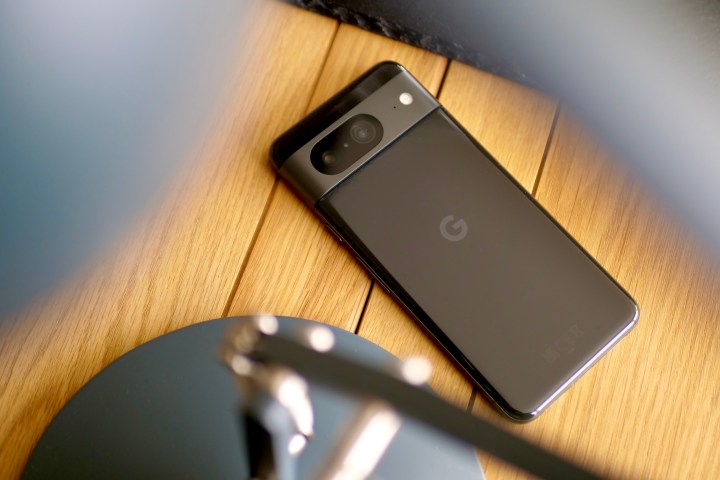
The Google Pixel 8 has a matte aluminum metal frame and a polished glass rear panel, with Gorilla Glass Victus over the 6.2-inch screen, and it measures 8.9mm thick with a total weight of 187 grams. It also has an IP68 water and dust resistance rating and a large metal camera visor stretching across the top of the rear panel. It’s not drastically different from the Google Pixel 7 or the Google Pixel 6 in terms of looks, but it is when you pick it up.
It’s a much more compact phone than the last two, helped by the 0.1-inch reduction in screen size spread over the last two generations, and it’s also much lighter. The 150mm by 70mm dimensions make it very comfortable in your hand (Asus’s research says this is the perfect size for a one-handed use phone, and it sticks to this formula for its Zenfone series), and it never becomes tiresome or awkward. The more curved corners look modern and help it sit comfortably in your palm.
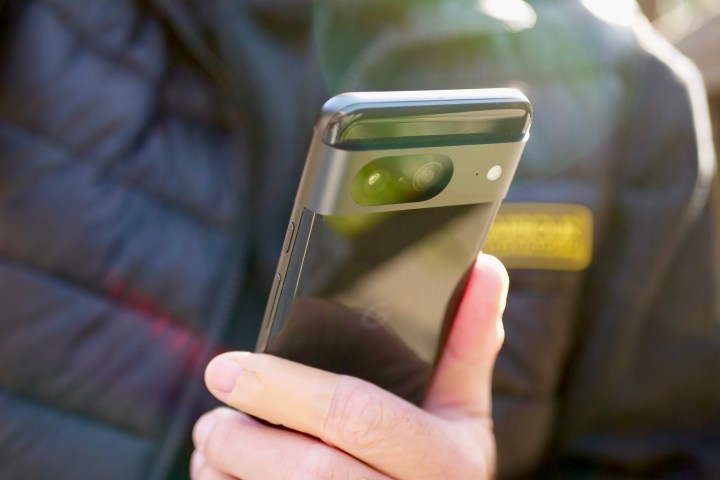
The side buttons are easy to locate and press, plus the in-display fingerprint sensor is quick and accurate. I don’t always have to use the fingerprint sensor, as Face Unlock usually gets there before me. Even better, Google has updated the system for the Pixel 8 so it meets requirements for payment and in-app authorization too. The smooth, easy security is another reason living with the Pixel 8 is so pleasant, and there are no compromises on it compared to the Pixel 8 Pro.
Most of the time, the Pixel 8 has lived inside Google’s silicone case, which does get covered in dust and lint, but it is also probably wise to use such a thing. I’ve removed it mostly just to take photos of the phone, but during this time, it has picked up a pair of scratches on the glass back already. They’re visible in the right light but not all that noticeable under your fingernail, and it’s a little concerning it has scratched so quickly.
The Pixel 6 and Pixel 7 were quite large phones, and while the Pixel 8 is still quite thick and slab-like, it’s considerably more hand-friendly and can accurately be described as compact this time around. The Pixel 8 is a modern, lightweight, almost perfectly-sized smartphone.
Google Pixel 8: camera
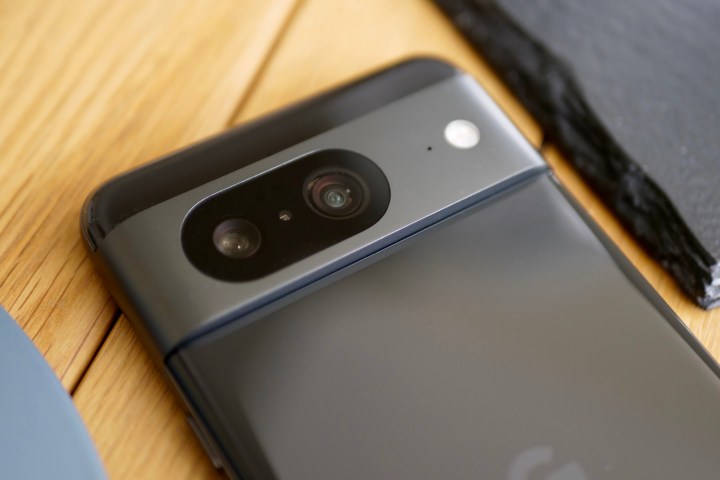
The main 50-megapixel camera on the Pixel 8 is the same as the Pixel 8 Pro and comes with optical and electronic image stabilization (OIS and EIS), and it has an f/1.68 aperture. The wide-angle camera has 12MP and a 125.8-degree field of view, but there’s no dedicated telephoto camera, so you make do with the 2x “optical quality” zoom provided by the main camera. The selfie camera has 10.5MP and fixed focus.
It won’t come as a surprise to learn the main camera is excellent. The photos it takes are vibrant and exciting, yet still natural looking. It never veers into over-saturated territory but keeps colors punchy and fun to ensure you want to share them online with minimal editing. Zoom in to 2x (there’s a shortcut in the camera app to do so), and you will see a slight degradation in quality if you crop the image, but otherwise, it looks surprisingly good.
At 5x digital zoom, there’s obviously pixelation, but at the maximum 8x Super Res zoom, a lot of this is removed by Google’s software, and the final image looks far better than you may expect. Night Sight brightens images a lot (the photo of the logs in the gallery above was in almost complete darkness and shot with a three-second exposure), but it does add grain and blur when it’s very dark. But to find fault with the vast majority of photos taken with the Pixel 8 is just nitpicking.
It’s easier to find fault with the wide-angle camera, though, which has a disappointingly low megapixel count, and although the colors, contrast, and tones in the photos it takes are consistent with the main camera, the detail levels when you crop the image or look very closely can’t compete. It’s certainly worth getting the Pixel 8 Pro if you take a lot of wide-angle photos. The macro mode suffers due to the wide-angle’s poor quality too.
Put these things aside (the Pixel 8 isn’t the only phone lumbered with a disappointing wide-angle camera this year), and you’re left with an immensely capable main camera that takes amazing photos. It’s not as versatile as its more expensive sibling due to its mostly digital zoom feature, but many people won’t care at all. As an overall package, the Google Pixel 8 is so rewarding to use.
Google Pixel 8: Magic Editor
- 1. Before Magic Editor
- 2. After Magic Editor
The photos you take with the Pixel 8 can be edited to a degree never seen before on a smartphone. Magic Editor is Google’s latest generative AI tool, and it allows you to manipulate the image to a massive degree — from removing or shifting objects and people to changing the look of the sky and water. It can be shockingly effective, and best of all, it’s so simple to use.
Magic Editor uses Google’s cloud-based generative AI to make its adjustments. To remove objects, you trace around them as you did with Magic Eraser, but here the app generates a replacement background rather than just softening and smoothing it. It works best with simple shapes in the background and can still get confused by people unless they’re small aspects of the image. You can also select objects and move them about in the frame, with Magic Editor even able to create new parts of the image to fill in the blanks when you do.
To change the overall look of the photo, Magic Editor gives you various choices, and if you don’t like any of them, they can be refreshed multiple times. The alterations can be startling, and while most aren’t convincingly real, they certainly do add fun to the editing process. Magic Eraser is also onboard, along with a new feature called Best Take, where you can face-swap your friends with a better shot if they ruin the photo by not smiling. You can see it in action in our Google Pixel 8 Pro review.
It’s all technically very impressive, and I have had fun with Magic Editor, especially when cleaning up signs and other distracting background features from shots. However, it’s a bit of a gimmick, and I wouldn’t always want to use Magic Editor’s scene alteration system, not least because it could mean some special yet imperfect photos could be lost or discarded due to its huge talent, and that would be a shame.
- 1. Edited with Google’s Magic Editor
- 2. Edited with Google’s Magic Editor
- 3. Edited with Google’s Magic Editor
- 4. Edited with Google’s Magic Editor
All these questions and concerns will be forgotten the first time you use Magic Editor or Magic Eraser, though. These tools are astonishingly powerful, and it’s deeply impressive we have the ability to change photos to this extent on a smartphone. You won’t find Magic Editor anywhere else except on the Pixel 8 and Pixel 8 Pro, and along with the entire Google Photos editing suite, a genuine reason to consider either one if you’re really into photography.
Google Pixel 8: screen and performance
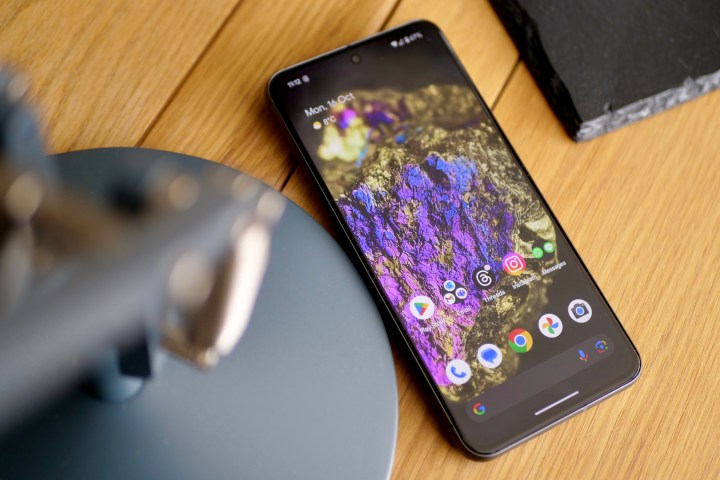
The 6.2-inch screen is an OLED “Actua Display” panel with a 2400 x 1080 pixel resolution, a 2,000-nit peak brightness, and a variable refresh rate between 60Hz and 120Hz. It’s the main difference between it and the Pixel 8 Pro, which does have a brighter, more pixel-dense screen with a greater variable refresh rate and even stronger glass over it. Both Pixel 8 phones use Google’s new Tensor G3 chip, and the Pixel 8 has 8GB of RAM.
We don’t publish benchmarking tests in our reviews at Digital Trends — they’re just numbers and can be easily manipulated — but I often use the 3DMark app and its 20-minute Wild Life Extreme Stress Test to assess heat buildup and to see how it handles really hardcore games. Given the Tensor’s love of getting warm in the past, how would the Tensor G3 handle the test? It does get very warm, but I wouldn’t call it hot, and it’s certainly not scalding. The phone works hard, just as you’d expect during this test, but it never becomes a concern. This is a good sign for anyone who wants to play a lot of games.
The screen may not get quite as bright as the Pixel 8 Pro’s screen, but I’ve had no problem seeing it outside in the fall sunshine and at various angles too. I only want enough brightness to see the screen, and the Pixel 8 fulfills my needs, so I’m not sure how much benefit I’d get from the Pro here. Despite being technically flat, the body blends into the screen with a nice curve and avoids any sharpness. It also isn’t overly reflective, and the bezels are slim around the sides. It’s sharp and colorful when watching videos.
I’ve had no issues using normal phone-related stuff, with calls sounding great either through the speaker or when I use Bluetooth-connected earbuds. The Pixel 8 pulls in a strong signal connected to both 4G and 5G, while NFC and Google Pay work faultlessly. At this stage, the Tensor G3 is a better, more reliable performer than previous versions, giving the Pixel 8 masses of speed and ability. I just hope it stays this way.
Google Pixel 8: software
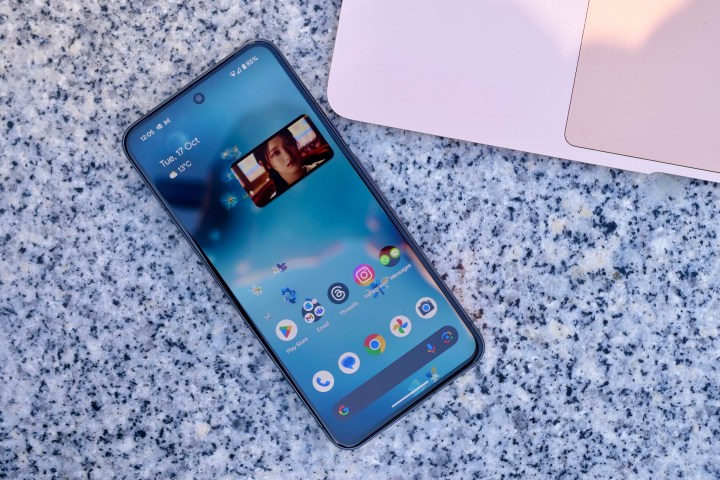
Android 14 is installed on the Pixel 8, and Google is promising seven years of major Android updates and security updates, along with its regular feature drops. This is excellent long-term support and even better than Samsung and OnePlus’s four-year support commitment. It means you could keep your phone until 2030, and the software would still be as up-to-date as possible. Whether the hardware would be is another question.
If you’ve used a phone with Android 13 onboard, the Pixel 8’s Android 14 software will feel very familiar. The operation, design, and fluidity are very similar, and I barely noticed any changes coming from the Pixel 7 Pro. If Magic Editor didn’t already drop enough hints about Google going all-in with AI on the Pixel 8, the smattering of new features in Android 14 will.
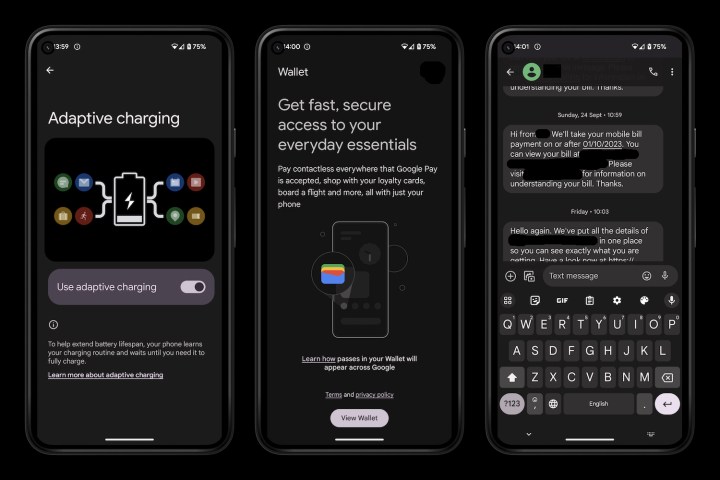
For example, Google Assistant will read web pages and documents out loud; it will screen, manage, and even respond to calls so you don’t have to, plus it can provide summaries of websites. Even more AI features are coming at a later date, although not all will be available on the Pixel 8. For example, the Zoom Enhance feature for the camera is a Pixel 8 Pro exclusive, as is the camera’s Pro mode. Each existing AI feature has its place, but likely won’t be used by everyone and aren’t reasons to buy.
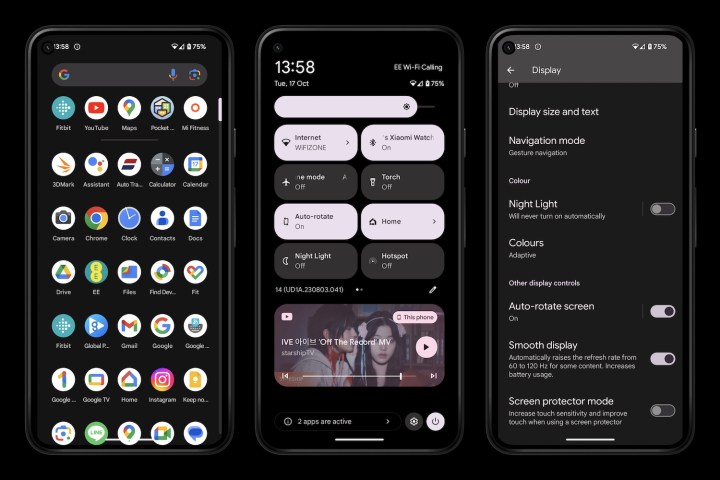
You may have more fun with the AI-generated wallpapers. Have you ever wanted to see what a wallpaper depicting a scene showing surreal cliffs in shades of indigo would look like? Google’s AI wallpaper will show you. It’s fun and different. I also like the varied ways you can customize the lock screen, from the layout of the time and date to adding handy shortcuts. Android has always been customizable, but Google has worked hard on making these tweaks accessible and good-looking in Android 14.
Android 14 on the Pixel 8 has been very reliable for me. I have not encountered any bugs, all my apps work without issue, and navigating and interacting with the software is intuitive and fast. It’s all you really need from a smartphone, and the varied AI features only add to its general appeal.
Google Pixel 8: battery and charging
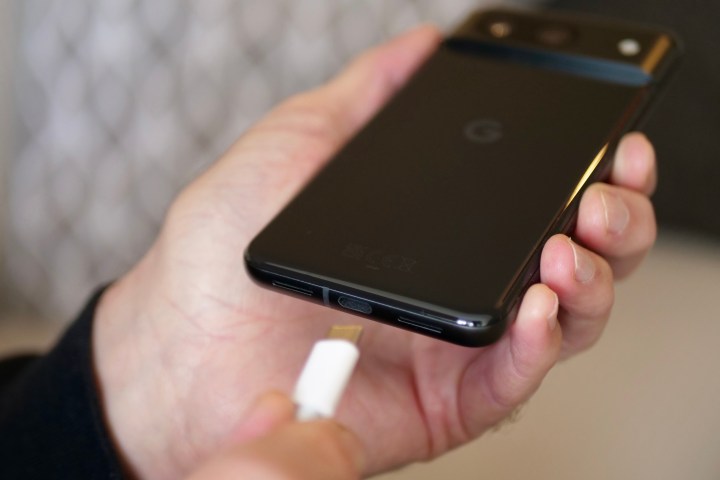
A 4,575mAh battery hides inside the Pixel 8, and because it sounds a little small, I did have some concerns over how long it would last. Google’s Tensor chip hasn’t been the most efficient, and the Pixel range has long had a reputation for disappointing battery life. The Tensor G3 didn’t seem to improve battery life in our Pixel 8 Pro either, but remember, it’s driving a larger, more advanced, higher resolution screen compared to the Pixel 8.
This does seem to make a difference, and my worries have been unfounded. My normal three hours of screen time and use per day sees the battery last deep into a second day, and not once has it threatened to expire at the end of the first day, even when connected to the Google Pixel Watch 2. A heavy four hours of screen time takes about 50% of the battery, which includes gaming, streaming video, apps, calls, and camera use. Provided your use isn’t too extreme, the Pixel 8’s battery will last two days before it needs recharging.

For a little more granular information on battery performance, streaming YouTube for 30 minutes depletes the battery by just 2%, recording a 4K Timelapse video for 15 minutes takes 4%, and 30 minutes playing Pocket City takes 7% from the battery. These results are equal to, if not even better than I’d expect to see from any current, high-performance smartphone.
You don’t get a charger in the box, and if you want the fastest charger, you must own or buy one with support for USB-PD 3.0 PPS technology, putting out at least 30W of power. Google claims this will deliver a 50% charge in about 30 minutes. To check, I used an Anker GaN charger, and it went from around 2% to 58% in 30 minutes, and in total, it took 75 minutes to fully recharge. The Pixel 8 also has 18W Qi wireless charging and reverse wireless charging.
Google Pixel 8: price and availability

A Google Pixel 8 with 128GB of storage space costs $699, and increasing the internal storage to 256GB sees the price rise to $759. There are three color choices — Obsidian (which is the model in our photos), Hazel, or Rose. The phone can be purchased through Google’s own online store or with AT&T, T-Mobile, and Verizon. In the U.K., the Pixel 8 starts at 699 British pounds.
The Pixel 8 is $100 more expensive than the Pixel 7. This rise brings it closer to the Samsung Galaxy S24 and the OnePlus 12‘s retail price of $799. It has become more expensive than the $599 Motorola Edge (2023) and the Nothing Phone 2 — and much more than the $499 Samsung Galaxy A54. All are excellent smartphones, just with different specialties. If you want very fast charging, the OnePlus 12 is for you, but if you want an eye-catching design, the Nothing Phone 2 will definitely fit the bill, for example.
Why wouldn’t you want the Pixel 8?
It’s no longer quite the midrange bargain it once was, but the price increase doesn’t put the Pixel 8 out of contention for those seeking a bargain entirely, as it’s still another $100 step up to “flagship” devices like the Galaxy S24. The good news is, you’re certainly not going to notice a step down in build quality, software, or camera ability if you get the Pixel 8. Yes, it’s more expensive than last year, but I’d say it’s a better-designed phone, with some truly cutting-edge software features to enjoy on the camera that you won’t find in the competition.
Google Pixel 8: verdict
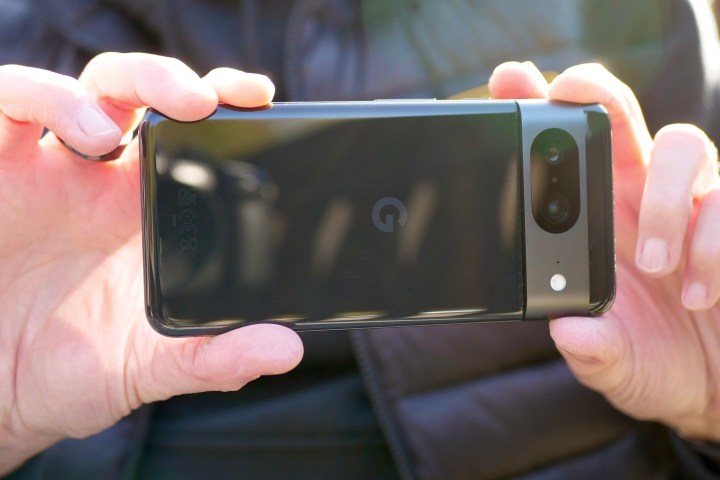
Why would you want to buy the Google Pixel 8? The more appropriate question is why wouldn’t you want the Pixel 8? It’s more compact, lighter, and better looking than ever before. The battery lasts two days with general use, even when connected to a smartwatch. The camera takes amazing photos, and the AI editing features are unlike anything else. Plus, the brilliant software will be updated until 2030. All this is yours for $699.
The Pixel 8 Pro certainly earns its Pro name with the more advanced camera and screen, plus a greater number of AI features to come in updates, but it costs $999. That’s a big jump up! The more modestly specced Pixel 8’s longer battery life is a reason to think hard about your priorities when choosing between these two phones.
When two brand new phones are released, it’s easy to think the best thing to do is just buy the Pro or more expensive model, but Google has got the Pixel 8’s specification, performance, and ability just right so you don’t have to feel this way. I have been extremely happy with it as my main phone, so the Google Pixel 8 gets an enthusiastic recommendation from me, regardless of how much you have to spend.
Editors' Recommendations
- A new Google Pixel Tablet is coming, but it’s not what you think
- Best Google Pixel deals: Save on Pixel 8, Pixel Buds, and Pixel Watch
- Google Pixel 8a: news, rumored price, release date, and more
- The Google Pixel 8a leaked again, and now I’m nervous
- This Google Pixel 8a leak just spoiled everything about the phone




